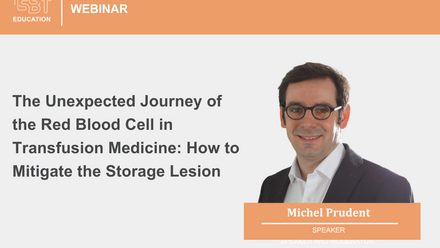The Change management - evidence based decisions session included the following presentations:
1. Barbee Whitaker: Modeling the Effect of an Individual-Risk Based Deferral Policy for Sexual Behaviors on Blood Donations in the US
2. Rachel Thorpe: Understanding preferences for advancing inclusion of trans and gender diverse people in blood donation in Australia
3. Stephen Thomas: Safety profile of plasma for fractionation donated in the United Kingdom, with respect to variant Creutzfeldt-Jakob Disease
4. Antoine Lewin: Risk of variant Creutzfeldt-Jakob Disease for the Canadian Blood Supply
5. Veronica Hoad: Is Dual Testing for hepatitis C necessary? Risk Modelling and Cost Effectiveness of removing hepatitis C antibody testing for Australian blood donors
6. Jennie Haw: Advancing inclusivity and equity for trans, nonbinary, Two-Spirit and other gender-diverse donors
MODERATORS: Eric Jansen and Marja-Kaisa Auvinen
After the presentation, there was a questions and answers session of about 5 minutes, which is also included in the recording.
Abstract
Safety profile of plasma for fractionation donated in the United Kingdom, with respect to variant Creutzfeldt-Jakob disease
S Thomas1, B Roberts2, D Domanovic3, K Kramer4, D Klochkov5, S Sivasubramaniyam6, D Miloslavich7, J Plancon8, F Rossi9, D Misztela10, L Kirkpatrick11, G Miflin12, J Birchall13, L McLintock14, R Knight15
1Joint UK Blood Transfusion and Tissue Transplantation Services Professional Advisory Committee, 2Department of Health and Social Care, London, United Kingdom, 3European Blood Alliance, Brussels, Belgium, 4Wageningen University, Wageningen, Netherlands, 5CSL Behring, Bern, Switzerland, 6CSL Behring, Haywards Heath, United Kingdom, 7Marketing Research Bureau, Greenacres, United States, 8EPODIN, Baule, France, 9International Plasma and Fractionation Association, Amsterdam, Netherlands, 10Plasma Protein Therapeutics Association, Annapolis, United States, 1111 Northern Ireland Blood Transfusion Service, Belfast, 12NHS Blood and Transplant, London, 13Welsh Blood Service, Cardiff, 14Scottish National Blood Transfusion Service, 15UK National CJD Research & Surveillance Unit, University of Edinburgh, Edinburgh, United Kingdom
Background: Plasma-derived medicinal products (PDMPs) are life-saving and life-improving therapies, but demand is rising and the starting material is in short supply: Europe depends on importation of PDMPs manufactured with plasma from countries including the United States of America (US). Plasma from United Kingdom (UK) resident donors has not been fractionated since 1999 when this precautionary measure was introduced in response to the outbreak of variant Creutzfeldt-Jakob Disease (vCJD).
Aims: We gathered the latest evidence on the safety of UK plasma for fractionation and present it for review.
Methods: The epidemiology of vCJD over the last 23 years was reviewed, as were PDMP manufacturing processes. We reviewed recent risk assessments and regulatory policy changes in the UK and other jurisdictions, and performed a risk analysis using mathematical modelling. Blood service, industry and patient viewpoints were included, and ethical issues were considered.
Results: The vCJD outbreak was much smaller than had been feared and there have been no transfusion transmissions since 1999, when leucodepletion was introduced (allowing for an assumed eight-year incubation period more than 40M components were transfused up to 2015).
There are numerous and effective vCJD risk-reduction steps in the plasma donation and manufacturing process of PMDPs, and effective sanitisation processes in place in fractionation facilities. In February 2021, after a review by the UK Medicines and Healthcare products Regulatory Agency, the UK Government authorised the use of UK plasma to manufacture immunoglobulin for UK patients, and extended this to albumin in February 2023. Following separate reviews concluding no significant difference in the risk posed, the US, Australia, Ireland, Hong Kong and Israel also lifted their deferrals of blood donors with a history of living in the UK.
Mathematical modelling showed that the risk from each unit of donated plasma that is fractionated, using a process with a 4-log prion reduction factor (the industry minimum requirement), is over 7000 times less likely to lead to a vCJD transmission than if that unit was used for transfusion. This suggests that there would be less than one death from vCJD for every 36.4 billion units of UK plasma that are fractionated—this approximates to one possible death from vCJD transmission every 33,000 years. There is considerable uncertainty in the precision of this modelling and these numbers should be viewed with some caution but it is clear that the probability of vCJD transmission through the use of UK plasma for fractionation is extremely low.
Industry and patient groups support the review of guidelines that may enable the use of UK plasma and would bring significant immediate benefits to patients and to the resilience of the European supply chain. It is ethical to do so give the opportunity to provide significant benefits to patients currently in need of treatment.
Summary/Conclusions: UK Plasma is safe for fractionation and blood regulators and operators are strongly encouraged to review their guidelines in the context of current safety evidence and the rising demand for PDMPs in Europe.




